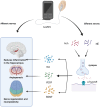Transcutaneous vagus nerve stimulation: a new strategy for Alzheimer's disease intervention through the brain-gut-microbiota axis?
- PMID: 38476661
- PMCID: PMC10927744
- DOI: 10.3389/fnagi.2024.1334887
Transcutaneous vagus nerve stimulation: a new strategy for Alzheimer's disease intervention through the brain-gut-microbiota axis?
Abstract
Transcutaneous vagus nerve stimulation (tVNS) is an emerging non-invasive technique designed to stimulate branches of the vagus nerve distributed over the body surface. Studies suggest a correlation between the brain-gut-microbiota (BGM) axis and the pathogenesis of Alzheimer's disease (AD). The BGM axis represents a complex bidirectional communication system, with the vagus nerve being a crucial component. Therefore, non-invasive electrical stimulation of the vagus nerve might have the potential to modify-most of the time probably in a non-physiological way-the signal transmission within the BGM axis, potentially influencing the progression or symptoms of AD. This review explores the interaction between percutaneous vagus nerve stimulation and the BGM axis, emphasizing its potential effects on AD. It examines various aspects, such as specific brain regions, gut microbiota composition, maintenance of intestinal environmental homeostasis, inflammatory responses, brain plasticity, and hypothalamic-pituitary-adrenal (HPA) axis regulation. The review suggests that tVNS could serve as an effective strategy to modulate the BGM axis and potentially intervene in the progression or treatment of Alzheimer's disease in the future.
Keywords: Alzheimer’s disease; HPA axis; brain-gut-microbiota axis; microbiota; transcutaneous vagus nerve stimulation.
Copyright © 2024 Yan, Li, Qian, Zhang, Cong, Zhang, Wu, Wang, Wang and Yu.
Conflict of interest statement
The authors declare that the research was conducted in the absence of any commercial or financial relationships that could be construed as a potential conflict of interest.
Figures



Similar articles
-
The vagus nerve: An old but new player in brain-body communication.Brain Behav Immun. 2025 Feb;124:28-39. doi: 10.1016/j.bbi.2024.11.023. Epub 2024 Nov 19. Brain Behav Immun. 2025. PMID: 39566667 Review.
-
Recognizing the role of the vagus nerve in depression from microbiota-gut brain axis.Front Neurol. 2022 Nov 10;13:1015175. doi: 10.3389/fneur.2022.1015175. eCollection 2022. Front Neurol. 2022. PMID: 36438957 Free PMC article. Review.
-
Microbiota-gut-brain axis in the Alzheimer's disease pathology - an overview.Neurosci Res. 2022 Aug;181:17-21. doi: 10.1016/j.neures.2022.05.003. Epub 2022 May 14. Neurosci Res. 2022. PMID: 35577241 Review.
-
Gut Microbiota Composition and Epigenetic Molecular Changes Connected to the Pathogenesis of Alzheimer's Disease.J Mol Neurosci. 2021 Jul;71(7):1436-1455. doi: 10.1007/s12031-021-01829-3. Epub 2021 Apr 8. J Mol Neurosci. 2021. PMID: 33829390 Review.
-
The Effects of Transcutaneous Vagus Nerve Stimulation on Functional Connectivity Within Semantic and Hippocampal Networks in Mild Cognitive Impairment.Neurotherapeutics. 2023 Mar;20(2):419-430. doi: 10.1007/s13311-022-01318-4. Epub 2022 Dec 7. Neurotherapeutics. 2023. PMID: 36477709 Free PMC article.
Cited by
-
Accrued reductions in heart rate following transcutaneous vagal nerve stimulation in adults with posttraumatic stress disorder.Front Neurosci. 2025 Mar 28;19:1456662. doi: 10.3389/fnins.2025.1456662. eCollection 2025. Front Neurosci. 2025. PMID: 40224646 Free PMC article.
-
Targeting gut microbiota: a potential therapeutic approach for tumor microenvironment in glioma.Front Neurol. 2025 Mar 21;16:1549465. doi: 10.3389/fneur.2025.1549465. eCollection 2025. Front Neurol. 2025. PMID: 40183013 Free PMC article. Review.
-
Novel Insights into Psychosis and Antipsychotic Interventions: From Managing Symptoms to Improving Outcomes.Int J Mol Sci. 2024 May 28;25(11):5904. doi: 10.3390/ijms25115904. Int J Mol Sci. 2024. PMID: 38892092 Free PMC article. Review.
-
Effect of probiotics on cognitive function and cardiovascular risk factors in mild cognitive impairment and Alzheimer's disease: an umbrella meta-analysis.J Health Popul Nutr. 2025 Apr 8;44(1):109. doi: 10.1186/s41043-025-00816-3. J Health Popul Nutr. 2025. PMID: 40200373 Free PMC article.
-
Transcutaneous vagus nerve stimulation: a bibliometric study on current research hotspots and status.Front Neurosci. 2024 Aug 16;18:1406135. doi: 10.3389/fnins.2024.1406135. eCollection 2024. Front Neurosci. 2024. PMID: 39221007 Free PMC article. Review.
References
-
- Ainsworth M., Lee S., Kaiser M., Simonotto J., Kopell N. J., Whittington M. A. (2016). Gabab receptor-mediated, layer-specific synaptic plasticity reorganizes gamma-frequency neocortical response to stimulation. Proc. Natl. Acad. Sci. U. S. A. 113, E2721–E2729. doi: 10.1073/pnas.1605243113, PMID: - DOI - PMC - PubMed
Publication types
LinkOut - more resources
Full Text Sources

